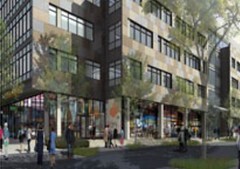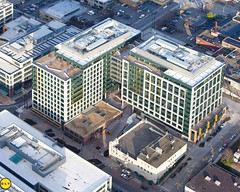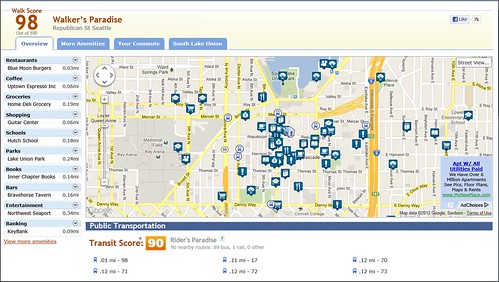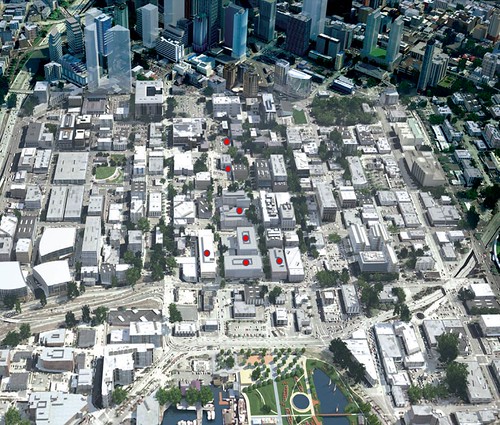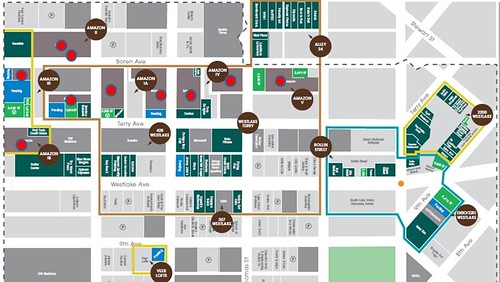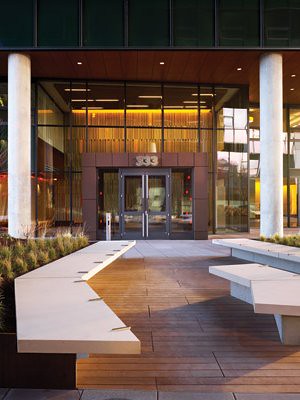A high-tech corporate giant strengthens a walkable, transit-accessible neighborhood

Posted March 14, 2012 at 1:29PM
Despite being all-in with blogging and social media, I’ll confess to some ambivalence toward electronic media that displace bricks-and-mortar retail experiences. Whether it’s Apple’s iTunes dealing the final death blow to music stores or Amazon’s retail ubiquity finishing off bookstores, I find myself wondering whether it’s all worth it. But I suspect I am both showing my age and clinging to a model of doing business that jumped the shark at least a decade ago.
That said, I am hugely impressed by Amazon’s strong commitment to a walkable urban environment in Seattle’s South Lake Union neighborhood, where the company is finishing its new headquarters Located right on the Seattle Streetcar line, the 1.7 million square feet of office space will comprise eleven separate buildings, including two historic buildings that are being adaptively reused. The company's new headquarters is distributed along a highly connected street grid amidst some 3,000 residential units and a large variety of shops and services, including 100,000 square feet of new ground-level retail within Amazon's own buildings.
Using a location in the center of the Amazon buildings, I obtained an impresive “walker’s paradise” Walk Score of 98, supported by a “rider’s paradise” Transit Score of 90. That’s outstanding by any measure. (By contrast, a site picked in the middle of the location for the new Apple headquarters in Cupertino, which I reviewed yesterday, rated only a “car-dependent” Walk Score of 49.) In addition to the streetcar, there are nearly fifty bus routes running through the neighborhood. One can go directly to Seattle-Tacoma International Airport via rail transit with only one transfer.
According to a story written by Sheila Bacon Cain in Constructor, the magazine of the Associated General Contractors of America, construction on the first phase started in early 2008, and employees are already housed in all but the last of the buildings, which is expected to be completed a year from now. The total cost of the Amazon project is approximately $700 million.
Red dots mark Amazon HQ buildings; note walkable street grid
The company’s commitment to the principles of smart growth and urbanism is impressive. Bacon Cain interviewed Sharon Coleman, an official with project developer Vulcan Real Estate:
“Vulcan intentionally hired a diverse cross section of designers and builders . . . ‘We decided early on that we wanted all the buildings to look different,’ Coleman says. ‘This is an urban development. We didn't want a suburban campus look.’ . . .
“An open-space plan, designed by Seattle firm LMN Architects, addresses seating, outdoor art, pedestrian walkways, landscaping, retail and access to public transit while creating connectivity and cohesiveness among the buildings. This ‘public realm’ plan was designed early and shared with all the buildings' architects as the project progressed, Coleman says.”
Notably, all of those amenities will be fully available to the public.
Building heights vary from five to 12 stories. All of the buildings are designed to obtain LEED-gold certification, and most contain at least partial green roofs. (Vulcan is owned by Paul Allen, philanthropist and co-founder of Microsoft.)
Peter Krech, principal at Callison, the project’s Seattle-based architecture firm, told Constructor that the new buildings were designed to complement the character of historic warehouses in the neighborhood. “Rugged materials with bold, textured concrete surround double-story, subdivided windows that evoke the historic wood-and-steel sash windows from the turn of the early 20th Century,” he noted.
Perhaps even better, Bellamy Pailthorp reports in a story posted on the website of Seattle NPR affiliate KPIU that Amazon’s developer Vulcan is paying $6.4 million to the City of Seattle to support groups such as Plymouth Housing in the construction of lower-income apartments in the area. Amazon's payment will also help provide for daycare needs in the neighborhood.
Nothing is perfect, but it is hard to find fault with Amazon’s concept and easy to find much to applaud in just about everything I have seen and read about the new headquarters. This is exactly the kind of environment that analysts are predicting will be most in demand in the coming decades. Sometimes businesses can become leaders in the revitalization of walkable neighborhoods, and I believe those that do will be well-positioned for more success.
Here’s a 30-sceond video showing both the Seattle Streetcar and a bike trail approaching Amazon’s new neighborhood:
Thanks to Mark Irvine and Don Carter for supplying information for this article.
Move your cursor over the images for credit information.
Please also visit NRDC’s Sustainable Communities Video Channel.
